Fall-Blooming Perennials & Grasses that Burst Into Color For Autumn
Gardens can sometimes start to look a bit tired as summer moves into it's final phases and fall arrives. Utilizing plants that bloom, develop brightly colored fruit or have great foliage color in later summer and fall is a great way to keep your garden looking fresh.
The best gardens have plants that add color and interest in all seasons. Spring and summer are usually pretty simple to fill with color. It can take a bit more planning to keep the garden looking great late summer into fall and winter. However, with a bit of careful plant selection your garden can brim with interest in every season. This article gives ideas on adding color to your winter garden and using annuals such as pansies, violas, ornamental cabbage and kale, Diascia, Nemesia and Osteospermum - to name a few - are a pretty established way of adding fall color. The plants that are a bit overlooked are perennials and shrubs that flower, fruit or have showy foliage in fall.
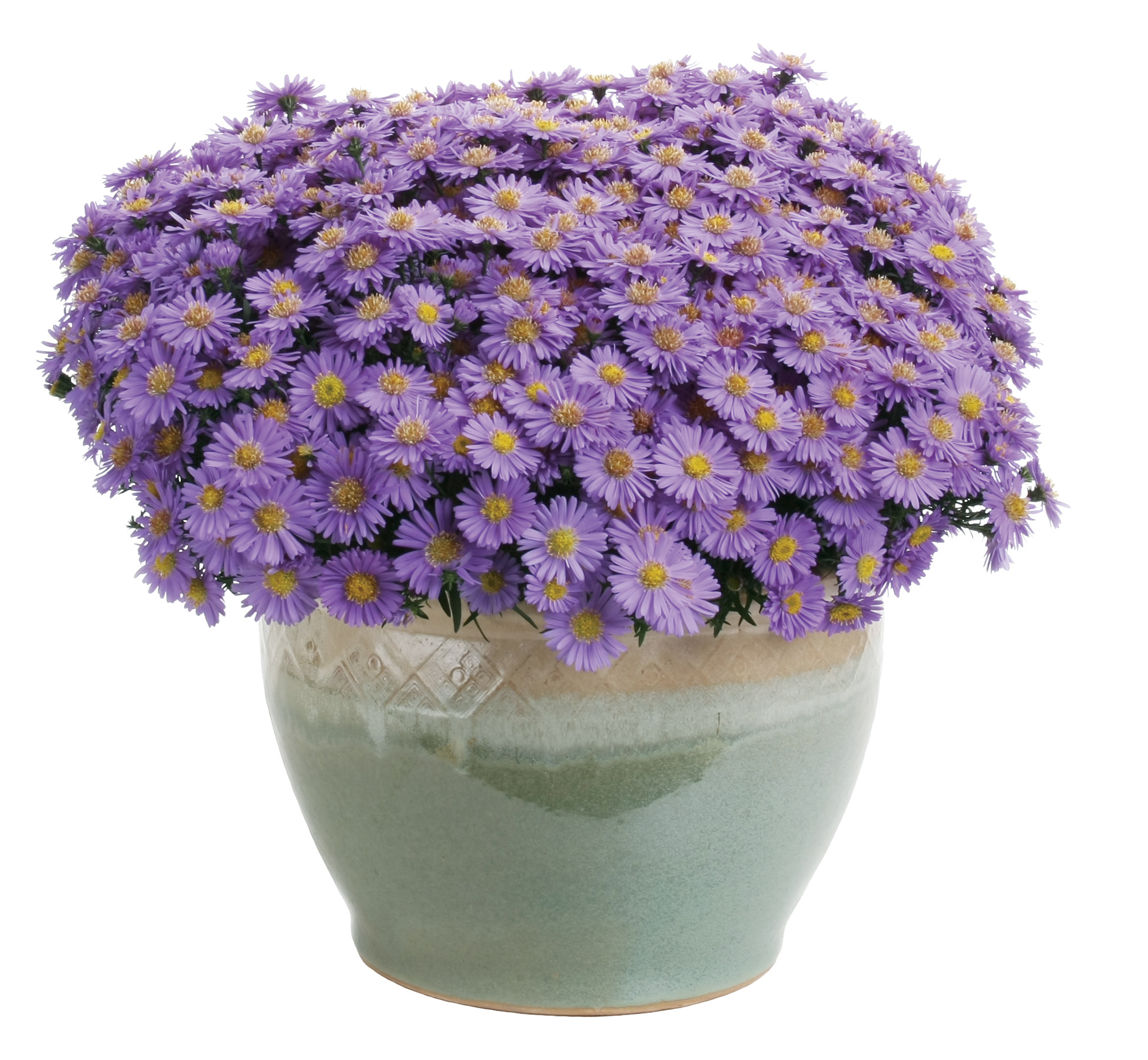 Perennials have always been looked to for color that persists over several years. Shrubs are increasingly being seen as adding flower color to the landscape. Carefully selecting and using perennials and shrubs that add color during late summer and fall can freshen up your garden without actually needing to add additional plant material. Here are some plants that will provide flower and/or foliage color during late summer and fall.
Perennials have always been looked to for color that persists over several years. Shrubs are increasingly being seen as adding flower color to the landscape. Carefully selecting and using perennials and shrubs that add color during late summer and fall can freshen up your garden without actually needing to add additional plant material. Here are some plants that will provide flower and/or foliage color during late summer and fall.
Asters and hardy mums are the two most traditional perennials to grow for fall flower color. Hardy mums are about as easy to grow as a perennial gets. They come in great autumnal colors - yellow, bronze, red, white, orange, burgundy and pink and are usually hardy in zones 5-9. When buying mums be sure you distinguish between hardy and florist mums. Hardy or garden mums are perennials. Florist mums are not.
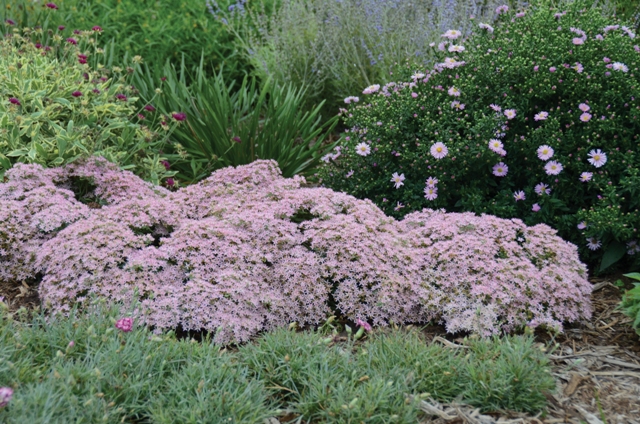 They do need just a bit of maintenance - trim them back between 1 and 3 times. The general rule I've always heard is, trim them back several times and then quit on the Fourth of July to get a great fall flower show. The trimming promotes branching and more branching will get you more flowers.
They do need just a bit of maintenance - trim them back between 1 and 3 times. The general rule I've always heard is, trim them back several times and then quit on the Fourth of July to get a great fall flower show. The trimming promotes branching and more branching will get you more flowers.
Asters are usually in the white, pink, lavender-blue color range. They come in compact and taller forms and are generally hardy in zones 4-8. Their one drawback is susceptibility to powdery mildew. To combat mildew, select varieties that are less susceptible to the disease (this information should be included in their description) and plant where they will receive plenty of sun and good air movement. Sun and air movement are important because powdery mildew thrives on damp foliage.
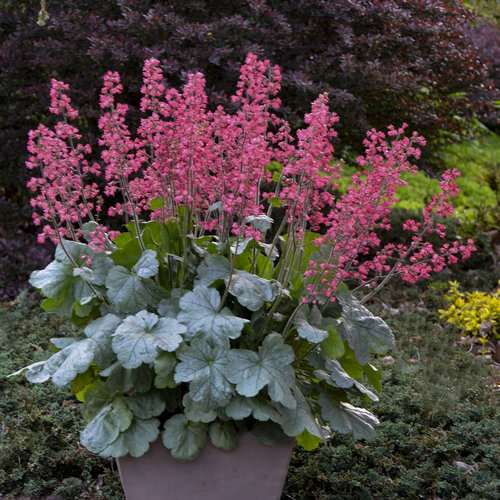 One of my favorite plants for this time of year is fall-blooming Sedums. They are heat and drought tolerant, don't mind poor soils, are generally hardy in zones 4-9 (check specific varieties because some will vary by a zone either way) and begin blooming in late summer. The color range is white, pink, red, burgundy and lavender. Some of my favorites are 'Pure Joy,' Garnet Brocade™, 'Maestro,' Autumn Joy and Neon.
One of my favorite plants for this time of year is fall-blooming Sedums. They are heat and drought tolerant, don't mind poor soils, are generally hardy in zones 4-9 (check specific varieties because some will vary by a zone either way) and begin blooming in late summer. The color range is white, pink, red, burgundy and lavender. Some of my favorites are 'Pure Joy,' Garnet Brocade™, 'Maestro,' Autumn Joy and Neon.
Heuchera, Coral Bells, such as our Dolce® series are primarily grown for their foliage. Most Heuchera foliage colors deepen, brighten or transform when temperatures are cool. They become more colorful versions of themselves. They will perform in sun and shade and are generally hardy in zones 5-9, but some are hardy to zone 4.
Perennial Hibiscus, such as our Summerific® series, is another class that will add color to the summer and fall garden. They actually start to bloom in mid-summer, but will continue to bloom deep into fall - October up in Michigan. The color range is pink, white, lavender and red, with some gorgeous bicolors. Blooms are often 6-8 inches across. 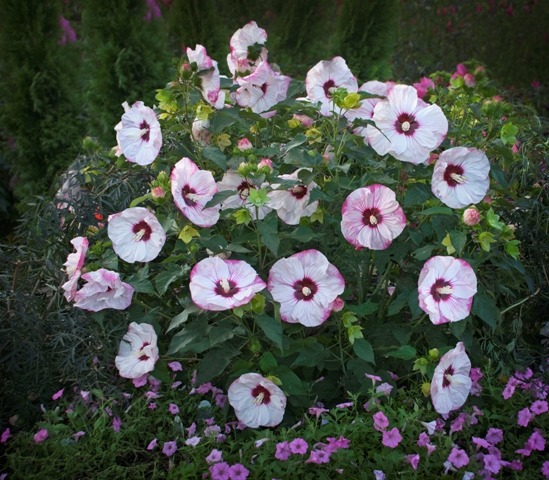 The plants are quite heat tolerant and prefer consistently moist soil. In general, they are hardy in zones 4-9 and are quite large - 4-5 feet tall and wide. However, more compact versions such as Summerific® 'Cranberry Crush,' which is 3-4 feet tall, do exist.
The plants are quite heat tolerant and prefer consistently moist soil. In general, they are hardy in zones 4-9 and are quite large - 4-5 feet tall and wide. However, more compact versions such as Summerific® 'Cranberry Crush,' which is 3-4 feet tall, do exist.
Hardy ornamental grasses are another good source of late summer and fall color, with many also adding winter interest. Panicum virgatum, or switch grass, is one good option. This native grass is adaptable to many conditions, but is best when soils aren't too rich. Rich soils will cause lush growth and the plants will be prone to falling over (the technical term is lodging.) The best foliage colors will occur in full sun, but it can be grown in partial shade. Although it does best with average moisture, it can tolerate drought. Two good cultivars to consider are 'Cheyenne Sky' and 'Apache Rose'
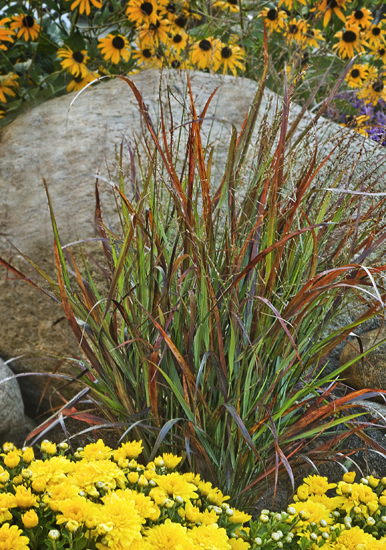 'Cheyenne Sky' is a compact form of switch grass, topping out at 3 feet tall, including flowers. The foliage is only 2 feet tall. It is great in landscapes and containers and works well when planted in a mass, although it does well as a specimen, too. It is hardy in zones 4-9. It starts out green in spring, but by late summer the foliage is wine-red, as are the flowers that are in full show. Unless the snow is very heavy, it will remain standing through the winter where it provides cover to birds.
'Cheyenne Sky' is a compact form of switch grass, topping out at 3 feet tall, including flowers. The foliage is only 2 feet tall. It is great in landscapes and containers and works well when planted in a mass, although it does well as a specimen, too. It is hardy in zones 4-9. It starts out green in spring, but by late summer the foliage is wine-red, as are the flowers that are in full show. Unless the snow is very heavy, it will remain standing through the winter where it provides cover to birds.
'Apache Rose' is a bit taller than 'Cheyenne Sky', topping out at 4 feet tall with flowers. It is also hardy in zones 4-9 and is a sturdy landscape plant. The foliage is blue-green, but becomes tipped in burgundy late in the season. It flowers in late summer and also provides good winter cover for birds.
While the purple fountain grasses are annuals, Pennisetum 'Desert Plains' is hardy in zones 5-9. It tops out at 4 feet tall and is about that wide. The more sun you can provide, the happier this plant is. In mid-summer the foliage tips begin to turn deep red and by fall the whole plant  is shades of gold and orange. It blooms in fall, with the large plumes emerging purply-pink and aging to tan. It is often considered to be the best hardy Pennisetum available.
is shades of gold and orange. It blooms in fall, with the large plumes emerging purply-pink and aging to tan. It is often considered to be the best hardy Pennisetum available.
Take a good look at your garden in late summer and fall and if you think it isn't all it could be, then consider one of these plants to add extra pizzazz. For more plants to add spice to your fall garden, read Shrubs that Bust into Color for Fall.
Patent Info: 'Pure Joy' Sedum hybrid PPAF Can. PBRAF; 'Maestro' Sedum (Hylotelephium) hybrid PP: 20094; Summerific® 'Cranberry Crush' Hibiscus hybrid PPAF Can. PBRAF, 'Dust Devil' Panicum virgatum PPAF; 'Desert Plains' Pennisetum alopecuroides PP: 20751, 'Cheyenne Sky' Panicum virgatum PPAF




